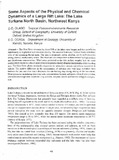| dc.contributor.author | Olango, D. O. | |
| dc.contributor.author | Odada, Eric O. | |
| dc.date.accessioned | 2013-06-11T14:13:28Z | |
| dc.date.available | 2013-06-11T14:13:28Z | |
| dc.date.issued | 2000 | |
| dc.identifier.uri | http://erepository.uonbi.ac.ke:8080/xmlui/handle/123456789/31733 | |
| dc.description.abstract | - The Omo River accounts for about 90% of the lakes water budget, and thus contributes.
significantly to its physical and chemical identity. The seasonal Kerio and Turkwel rivers contribute
most of the remaining fluvial input. The lake is moderately saline, alkaline, and is well mixed by
strong, diurnal, southeasterly winds. The dissolved salt composition is characterized by high sodium
and bicarbonate concentrations. Wind stress generated on the lake surface, coupled with the basin
morphometry results in a closed-gyre circulation pattern centred along the basins north-south trending
axis. The Omo River plume seasonally augments the subsurface currents and effects reductions in
salinity. The relative difference in the concentration of solvated ions with large hydration sizes
between the lake and river water determine the rate limiting step during mixing of the two waters.
Other processes modulating dissolved salts concentrations include authigenic mineral precipitation,
adsorption/exchange with suspended clay particles, biogenic uptake and bottom sediment resuspension. | en |
| dc.language.iso | en | en |
| dc.title | Some Aspects of the Physical and Chemical Dynamics of a Large Rift Lake: The Lake Turkana North Basin, Northwest Kenya | en |
| dc.type | Article | en |
| local.publisher | Tropical Palaeoenvironments Research Group, School of Geography, University of Oxford, | en |
| local.publisher | Department of Geology, University of Nairobi, | en |

